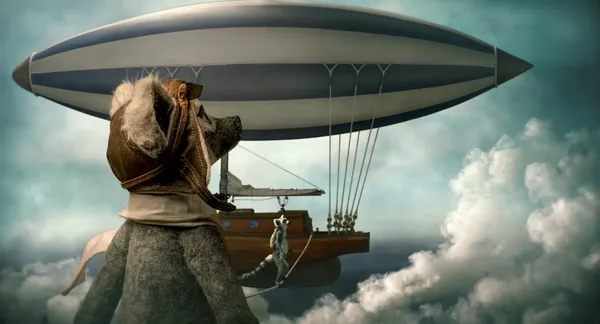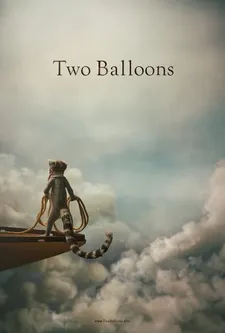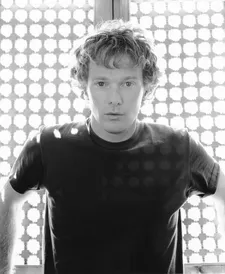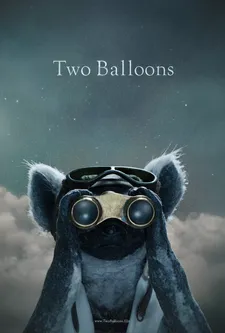 |
| "The biggest inspiration for the film was just where the original idea came from, it was a daydream" - Mark C Smith |
Two Balloons is a short stop-motion animation which shows two lemurs navigating their airships towards one another. I had a chance to ask director Mark C Smith about it during the Fantasia Film Festival, where it is part of the official selection. Two Balloons has also made it into Oscar-qualifying festivals such as Tribeca, as well as being awarded the Best Music Score at the New Renaissance Festival and the Special Mention Jury Award at Animafest Zagreb. Mark discussed what it was like to finally achieve his lifelong passion of creating a stop-motion film and where this interest all began.
Emilia Rolewicz: How did you go about deciding this should be a stop-motion animation?
Mark C Smith: Originally Two Balloons was going to be a live action film, but when the aircraft hangar we needed to accommodate the dirigibles became unavailable, we suddenly had a scale problem. I’ve always been drawn to stop-motion so I saw our scale problem as an opportunity to delve into a form of filmmaking that I’ve always wanted to experience.
 |
| Two Balloons poster |
ER: Was it always going to be lemurs as the characters, even for the live action?
MCS: It was going to be regular actors, but when we transitioned to stop-motion I thought if our characters were animals we’d be able to suspend disbelief easier. As I was deliberating over what our character’s should be I remembered a passage from a book called The Unquiet Grave. It’s by a writer named Cyril Connolly. In the passage I am referring to Connolly writes about his impression of lemurs when he first saw them. He remembers them as beings that held the secret to life, ‘’clues to an existence without thought, guilt or ugliness wherein all was grace, appetite and immediate sensation.’’ I can’t do justice by his prose, it’s just a really beautiful passage. When I reread it and put the book down the decision to go with the lemurs was easy.
ER: There was a bit of a Wes Anderson animation look to the film, what were your visual inspirations?
MCS: I really like Mackinnon and Saunders’ work in Wes Anderson’s stop-motion films. Their puppets are amazing. It would have been nice to work with them but when I asked for a quote it was cost prohibitive. The biggest inspiration for the film was where the original idea came from, a daydream. I was on a sailboat trying to get to an island at the end of the Windwards called Grenada. On a long passage I saw a funnel cloud for the first time, The cloud appeared to be about 600 feet high. As its conical shape skipped across the ocean surface I was listening to a song in ¾ time, the time signature of a waltz, and that’s when the idea for Two Balloons happened. It was the ocean, a song and a weather event that created the inspiration for the film.
After the funnel cloud passed, and in better weather, I made notes in my book and when I got home, surrounded myself with my friends and we stared story boarding. It took about 16 months to finish the storyboards and build the sets, and then we started production in a warehouse in Portland, Oregon.
ER: With this style of animation what was the biggest challenge?
MCS: The biggest challenge was understanding the language of stop-motion, it’s a form of filmmaking that kind of has a secret argot, it’s highly specialised.
 |
| Mark C Smith |
All of our sets were stationary, the camera had to create the movement of the ships. We fixed the ships to steel stands and used motion control of rigs to create parallax. The X, Y and Z axis were counter intuitive. We often brought the CAD drawings of the ships into a 3D programme that allowed us to previsualise our shots. We would use the renders as a guide, for our camera moves. We had ships falling out of the sky on the stage; but they were never moving, it was always the camera.
ER: What are some main differences between live action and stop-motion?
MCS: With live action the sky is already there, the clouds exist and the stars exist. In stop-motion those parts of the frame are referred to as elements. On Two Balloons, sometime a 10 second shot took a month to complete because there were many elements to film. An example is when Bernard and Elba, the two lemur characters, get swept up into the storm. On one stage we were animating Elba on her ship, and on a second stage we were animating Bernard on his ship. On a third stage we were photographing clouds on a light table and matte paintings. The stars were pin poked holes in foam-core and pulsed by utilising mylar strips. They were photographed with a 4K motion picture camera, as was our lightning strikes. For the latter we used a Tesla coil. The funnel cloud was made of wire and wool and was 12 feet high rotating on a model mover… All the elements I have mentioned were for a single shot, each element was filmed independently and had to be joined (composited) with the other elements in post.
Stop-motion can be a bit of a jigsaw puzzle. We were photographing the pieces and they were living on a hard-drives for months. There was an underlying anxiety because you really never knew if all of the elements were lit correctly, if the shadows were going to fall where they’re supposed to, until you combined the elements in post.
ER: Even in the chaotic moments everything still looks so elegant and calm, why did you go for this style? Was the overall aim of combining all these elements to mimic that feeling of watching the day-dream you described earlier?
MCS:Music definitely influenced the narrative. I feel songs have the ability to take us to an intuitive place, a lyrical place. I wanted Two Balloons to emulate that dynamic, to take an audience away from intellect and toward intuition.
 |
| Two Balloons poster |
ER: The blimp/boat-crafts are quite unique. What motivated this aspect? Was it also in the day-dream?
MCS: I’ve always been fascinated of the aesthetic of boats and planes from the 1930s and 40s, some of those designs have never been surpassed. During pre-production I accumulated thousands of photographs and drawings of airplanes and boats from the 1930s and 40s, and many of the attributes from those reference images found their way into the production design.
ER: How did your interest in stop-motion begin?
MCS: I think I fell in love with stop-motion before I knew what it was. Ray Harryhausen’s adventure films, Phil Tippet’s work on the first Star Wars movies… You could feel the stop motion without knowing the process, you knew the characters and shadows were real. What I saw on the screen felt genuine.
I’ve always wanted to tell a story through stop-motion and Two Balloons seemed like a good opportunity to challenge myself.
Portland, Oregon is home to many stop motion studios. They all lead back to Will Vinton who brought stop-motion to Portland in the 1970s. I don’t think Two Balloons could have been made in another city. The animation community in Portland helped us reach the last frame.
Mark ended the interview with the promise of sending me the Cyril Connolly quote which inspired the magical essence of his film, it seems appropriate to end this article with it too:-
“In youth the animal world obsessed me; I saw life through creatures which were in a state of grace, creatures without remorse, without duties, without a past or a future, owning nothing but the intense present and their eternal rhythm of hunger, sleep and play. The ring-tailed lemurs with their reverence for the sun, their leaps through the air and their howls of loneliness, were dark immortals of a primitive race…they held the secret of life to me; they were clues to an existence without thought, guilt or ugliness wherein all was grace, appetite and immediate sensation: Impressionist masterpieces which Nature flung upon the canvas of a day.”





















